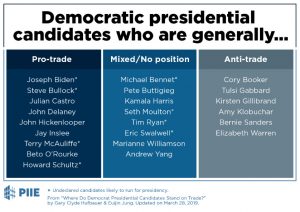The following article by Ruy Teixeira, author of The Optimistic Leftist and other works of political analysis, is cross-posted from his blog:
Can the Democrats Win with Identity Politics?
Perry Bacon Jr. considers this question in his latest article on 538. He starts out by noting:
The case for Democrats both running on populism and centering their electoral strategy around appealing to Midwestern white voters without college degrees is fairly strong. After all, polls show that voters are more aligned with the Democrats on some high-profile economic issues than on some hot-button cultural ones. Recent electoral history also seems to make this case. Then-President Barack Obama leaned heavily into economic populism during his successful 2012 re-election bid, when he won states including Michigan, Pennsylvania and Wisconsin. Hillary Clinton lost those three states and the election in 2016 after a campaign in which both she and President Trump spoke bluntly about issues around race and identity. In turn, Democratic congressional leaders emphasized a pocketbook messagefor the 2018 midterms, and the party’s candidates executed it, highlighting health care, particularly the GOP push to repeal Obamacare, more than perhaps any other issue. And the Democrats made huge gains in November.
Looking ahead to 2020, the easiest, clearest path for the Democrats to get 270 electoral votes is for them to win Michigan, Pennsylvania and Wisconsin, and all three states’ electorates have a higher percentage of whites without college degrees and a lower percentage of people of color than the nation overall. And those three states have already shown signs of bouncing back toward Democrats — the party won the governor’s race in all three in November.
I couldn’t have put it better myself. Bacon then proceeds to try to make the case for an alternative approach where Democrats “talk a lot about equality and identity issues, and…focus on turning out nonwhite voters and white people with college degrees as much as white people without degrees.”
One interesting point he makes here is is that Obama-Trump voters get a lot of attention but there are also Obama-nonvoter in 2016 and Obama-third party voters who could be targets and who have a different profile. So perhaps these voters need a good dose of identity politics. Bacon also notes how much of 2018 Democrats’ success was derived from opposition to Trump on non-economic issues like immigration..So identity politics could be a way of mining that part of the electorate.
Well, maybe. But it seems to me that any 2020 Democratic candidate will implicitly and explicitly be running against Trump’s rhetoric and policies around immigration and other culturally-inflected issues. I’m not sure a candidate needs to be very left or identity politics–oriented to convince voters that he or she is indeed an alternative to Trump and what he stands for.
But Bacon makes an interesting case and it’s worth reading. Honest fellow that he is, he admits that he himself does not completely buy his own argument and concludes:
“I’m making a case here, and it’s purposefully a bit provocative. The clearest way for Democrats to win in 2020 is for the party to carry Michigan, Pennsylvania and Wisconsin — three states that have lots of white voters without college degrees and where Trump’s tax and health care plans are very unpopular. Perhaps Democrats aren’t disciplined enough to talk about race and identity without also talking about related issues (reparations, for example) that may turn off swing voters…..So I’m not sure that this kind of non-economic liberalism is the best strategy for Democrats. But I’m not sure it isn’t either.”





